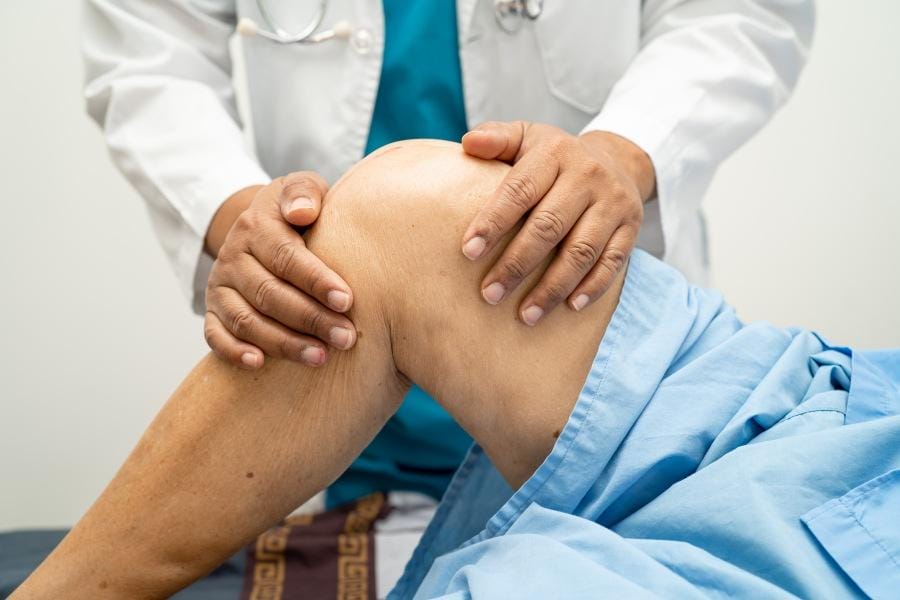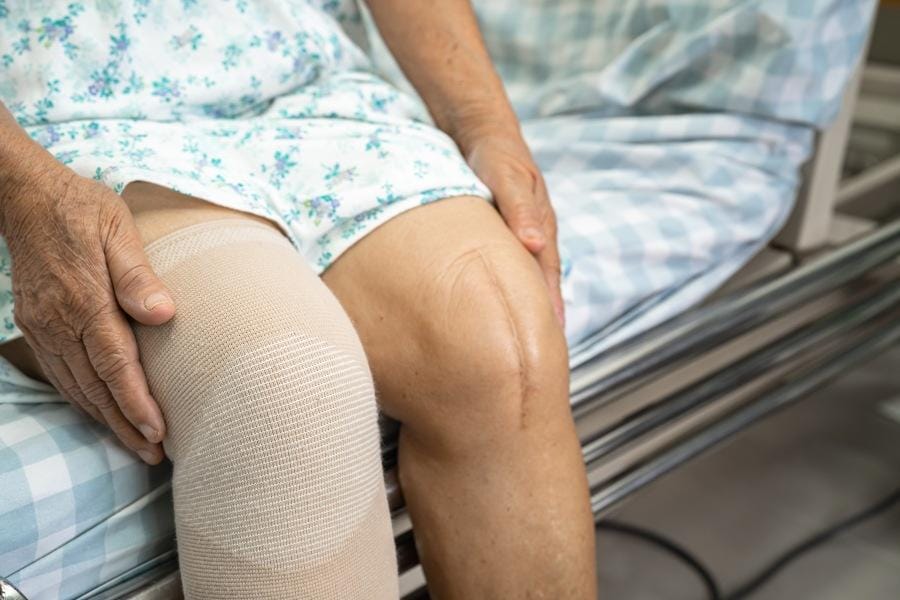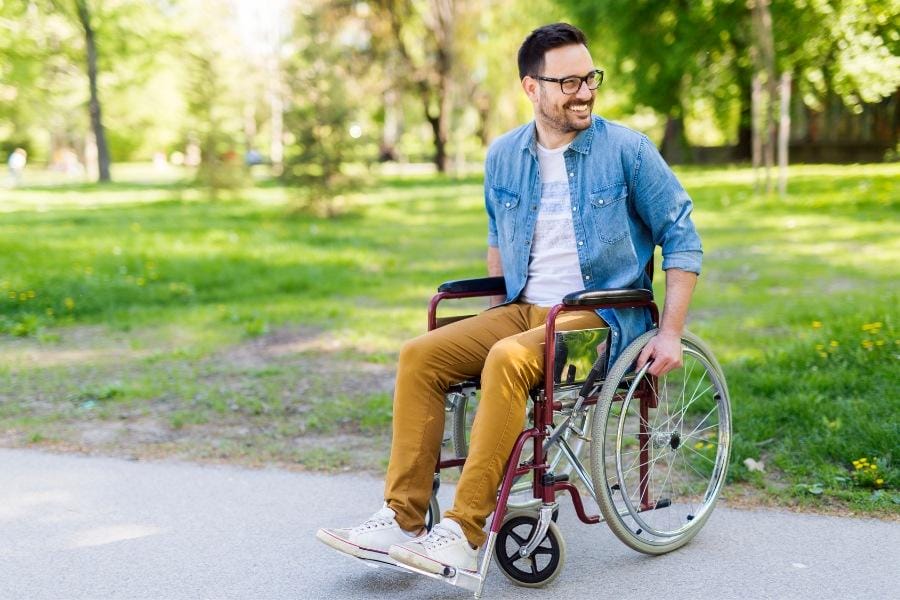Looking at knee replacement surgery can feel overwhelming, and one of the first questions many patients ask is: “How long will I actually be in surgery?”
Most knee replacement surgeries take between one and three hours to complete, depending on the type of procedure and the condition of the joint.
Your surgeon will consider several factors that could influence the duration.
If you have significant arthritis damage or previous injuries, the procedure might take a bit longer. Your overall health and any complications that arise during surgery can also affect timing, but most patients fall well within that standard timeframe.
Understanding what to expect can make a real difference in how you feel leading up to your surgery date. When you know the basics, you can better prepare yourself and your family for the day ahead, which often helps ease those pre-surgery jitters we all understand.
Of course, your time at the hospital extends beyond just the surgery itself. You’ll go through pre-operative preparation, receive anesthesia, and then spend time in recovery—each step carefully designed to ensure the best possible outcome for your new knee.
Key Takeaways
- Knee replacement surgery usually takes one to three hours.
- Recovery and physical therapy are important steps after surgery.
- Most people can return to daily activities within several weeks.
Duration of Knee Replacement Surgery
IN THIS ARTICLE

Knee replacement surgery is not the same for everyone. The time needed depends on the type of procedure and individual health needs.
Standard Time for Knee Replacement Procedures
Most knee replacement surgeries take between 1 to 2 hours from start to finish. Some surgeries may extend to 3 hours, especially if they are more complex or if the patient has unique medical concerns.
During these procedures, a surgeon makes an incision over the knee, removes damaged cartilage and bone, and fits new prosthetic parts.
The actual replacement work is often less than the full time spent in the operating room, because setup and anesthesia are also part of the process.
Post-surgery, patients spend some extra time in the recovery room under observation. The total operating room stay is usually longer than the surgery itself but rarely exceeds three hours in most standard cases.
For more details, see the timing information at NHS.
Factors That Affect Surgery Length
Total Knee Replacement vs. Partial Knee Replacement
There are two main types: total knee replacement and partial knee replacement.
A total knee replacement is more common and usually takes a bit longer, often 1 to 2 hours, because the surgeon replaces most or all of the joint surfaces.
In a partial knee replacement, only a section of the knee is resurfaced.
This type usually has a shorter surgery time, often closer to one hour. Partial procedures involve a smaller incision and less bone removal, making everything simpler and typically leading to quicker recovery.
The complexity of total knee replacement surgery increases the duration compared to partial procedures. Patients and doctors decide which option is best based on joint damage and age. More details can be found at Cleveland Clinic.
Step-by-Step Breakdown of Knee Surgery

Knee replacement surgery has several clear steps, from getting ready for the procedure to placing the new joint parts and closing the incision. Each stage is designed to make the process safe, effective, and as smooth as possible for the patient.
Preoperative Preparation
Before you’re wheeled into the operating room, your medical team takes you through a thorough preparation process designed with your safety as the top priority.
Your nurses will walk through a detailed checklist with you, double-checking everything from your identity to the specific details of your procedure. It might feel repetitive, but these verification steps are essential safeguards that ensure you’re getting exactly the right surgery.
You’ll change into a surgical gown, and your nurse will start an IV line in your arm or hand. This allows your team to give you fluids and any medications you might need throughout the process.
One of the most important conversations you’ll have is with your anesthesiologist. They’ll review your medical history and discuss whether general anesthesia (where you’re completely asleep) or spinal anesthesia (which numbs you from the waist down while you remain awake) works best for your situation. Both options are safe and effective—the choice often comes down to your health profile and personal preferences.
Your vital signs get recorded as your baseline, including blood pressure, heart rate, and temperature. These measurements help your team monitor how you’re doing throughout the entire procedure.
Finally, your surgeon will personally mark the leg that’s being operated on with a surgical marker. This might seem obvious, but it’s a critical safety step that prevents any confusion in the operating room.
Patients may also be given antibiotics to prevent infection. The team cleans the leg with an antibacterial solution, and sterile drapes are applied. These steps are important to lower the risk of complications and to ensure a safe start to the knee replacement surgery process.
Surgical Process and Incisions
Once the patient is fully prepared, the orthopedic surgeon begins by making a straight incision, usually 6 to 10 inches long, over the front of the knee. The length depends on patient size and the surgeon’s preference.
Muscles and soft tissues are carefully moved aside to expose the knee joint. The surgeon then removes the damaged surfaces of the femur (thigh bone), tibia (shin bone), and sometimes the patella (kneecap). Precision is important to remove only enough tissue to accommodate the new implant.
At this stage, the surgeon verifies that all diseased cartilage and bone have been cleared. The open surgical field offers direct access, allowing for accurate alignment and fitting of the prosthetic parts. Bleeding is controlled throughout, and the area is kept sterile.
Implant Placement and Closure
After the damaged sections are removed, the surgeon fits metal and plastic components onto the end surfaces of the femur and tibia. Special bone cement or screws may be used to secure these parts. The prosthetic joint is checked for stability and proper movement.
If the patella has been resurfaced, a plastic button is attached to its underside. The surgeon bends and straightens the knee several times to ensure the implant moves smoothly.
Once satisfied, the surgeon closes each tissue layer using sutures or staples. A drain may be inserted to collect excess fluid. The skin incision is closed, and a sterile dressing is applied. The patient is then moved to a recovery area for monitoring as the anesthesia wears off.
Immediate Postoperative Timeline

After knee replacement surgery, the first hours and days are important for monitoring recovery and helping the patient regain mobility.
Care teams focus on pain control, preventing complications, and starting gentle movement.
Recovery Room and Monitoring
Right after surgery, the patient is moved to a recovery room. Nurses and doctors carefully check vital signs like heart rate, blood pressure, and oxygen levels.
Pain is managed with medication. This can include opioids for severe pain in the first hours, but doctors often add acetaminophen or NSAIDs to limit opioid use and reduce side effects. The medical staff may use a pain scale to make sure discomfort stays under control.
The incision and dressing are inspected frequently for bleeding or unusual swelling. Special stockings or inflatable devices may be placed on the legs to help prevent blood clots. Oxygen is sometimes given through a tube in the nose for extra breathing support.
Most patients will stay in the recovery room for one to two hours. Once they are alert and their pain is controlled, they are moved to a hospital room for the next stage of recovery.
Hospital Stay Expectations
In the hospital room, staff continue to monitor for complications such as infection, deep vein thrombosis, or breathing issues. The leg is usually elevated, and ice packs may be used to limit swelling.
A physical therapist or nurse typically helps the patient sit up and do simple leg exercises within 24 hours. Early, gentle movement helps restore circulation and mobility. Patients may start using a walker or crutches as soon as they feel safe.
Managing pain remains important. The doctor may adjust the pain medicine and encourage switching from stronger opioids to acetaminophen or an NSAID as soon as possible. Nurses keep track of vital signs and help with basic activities like using the restroom.
Most people are able to go home after two to three days for a standard knee replacement. Discharge depends on being able to get in and out of bed, walk a short distance, and use the bathroom safely.
Pain Management After Surgery
After your knee replacement, some pain is completely normal and expected. Most patients find success with a combination of prescription medications and non-medication approaches to stay comfortable during recovery.
Effective pain management isn’t just about comfort—it actually helps you heal better. When your pain is well-controlled, you can move more easily, participate in physical therapy, and reduce your risk of complications like blood clots or stiffness.
Medications Used for Pain Control
Doctors use different types of pain medication following surgery.
Prescription opioids may be given for a short time, mostly during the first 1–2 weeks, to help control strong pain. These medicines are usually tapered as the pain lessens to reduce the risk of side effects and dependence.
Other common medications used include NSAIDs (non-steroidal anti-inflammatory drugs) such as ibuprofen, as well as acetaminophen. These help decrease swelling and control mild to moderate pain. Many doctors recommend combining these drugs to get better results and lower the dose of opioids needed.
Sometimes, a nerve block is given during or right after surgery to numb the area. Some patients also use local injections at the surgery site. The type and amount of medicine depends on the patient’s health and pain level.
For individuals recovering at home, you may choose to opt for in-home medication management services.
Non-Drug Strategies
Non-drug strategies work well alongside medicine to help manage pain. Applying ice packs to the knee can lower swelling and numb pain. Elevating the leg on pillows also helps reduce swelling during the first few days after surgery.
Physical therapy is a key part of recovery. Gentle exercises prescribed by a physical therapist can boost movement, strengthen muscles, and decrease stiffness. Using a walker or cane as advised is important in the early stages.
Other helpful steps include keeping the dressing clean and dry, and avoiding activities like kneeling, heavy lifting, or twisting. Patients should follow the care team’s instructions and report any severe or long-lasting pain, as this might signal a problem. Learn about the recovery process and more knee replacement rehabilitation tips.
Physical Therapy and Rehabilitation Process

Physical therapy and home exercises are crucial after knee replacement surgery. Rehabilitation allows patients to regain strength, mobility, and everyday function, often beginning just hours after surgery.
Early Mobilization and Assistive Devices
Early movement is important to prevent stiffness and speed up progress after knee replacement. Most people are encouraged to stand and walk with help on the day of surgery or the next morning. Physical therapists show patients how to get out of bed and move safely.
The use of assistive devices such as a walker, crutches, or cane is common at first. A walker is usually needed for the first 1–2 weeks, followed by a switch to a cane as balance and strength improve. Those using a cane should hold it in the hand opposite the operated knee.
Short, frequent walks around the hospital or home help keep blood moving and reduce swelling.
Higher-risk patients may also wear compression boots or stockings to reduce the risk of blood clots. Safe movement and proper use of mobility aids are reviewed before the patient leaves the hospital.
Initial Physical Therapy Sessions
Physical therapy starts within 24 hours after surgery, usually while the patient is still in the hospital. Therapists guide simple exercises to restore movement and build strength slowly and safely. Early sessions focus on basic skills, such as standing up from a chair, walking short distances, and learning how to use a walker or cane.
The goal in these first weeks is to straighten the knee fully and achieve a bend of at least 90 degrees. Swelling and pain may limit movement at first, but gentle activity helps prevent stiffness. Therapists check pain levels and watch for signs of trouble, adjusting activity as needed.
Therapy sessions are usually daily during the hospital stay, then continue several times a week as an outpatient or at home. Progress is measured by increasing walking time, independence with daily tasks, and improved knee flexibility.
Home Exercise Guidelines
Once discharged, patients are given a home exercise plan designed by the physical therapist. These exercises focus on improving strength, balance, and movement in the operated knee. Common exercises include:
- Straight leg raises
- Toe and heel raises
- Seated knee bends
- Standing hip abductions
- Step-ups on a low step
Home activities should be done several times each day. Consistent exercise helps speed recovery, reduce swelling, and improve walking ability. Patients should avoid activities that cause severe pain, excessive swelling, or a sense of instability.
Walking around the house, light chores, and practicing going up and down stairs with supervision can help restore confidence and strength. Patients are usually encouraged to increase the duration of walks on a weekly basis.
To assist in recovery, choosing a post-op nurse for home care could prove to be beneficial.
Timeline for Returning to Daily Activities

Resuming Regular Movements
Most patients take their first steps with a walker or crutches either the same day or within 24 hours of surgery. During that first week, you’ll practice basic movements like getting in and out of bed, sitting, and standing from chairs with your care team’s guidance.
Gentle walking is encouraged early on, but you’ll need to avoid kneeling, squatting, or climbing stairs until your doctor gives you the green light.
Gradual progress allows people to move from using walkers to canes, often by week 2 or 3. By the third week, many are able to walk and stand for more than 10 minutes at a time. Some may shower and dress without help by this point.
As rehabilitation continues, activities like cooking and light cleaning can be reintroduced, usually around week 4.
Physical therapy focuses on:
- Improving knee bending and straightening
- Gait training (teaching normal walking patterns)
- Strengthening leg muscles
Following these steps improves recovery and makes it safer to return to everyday routines.
When to Return to Work or School
Returning to work or school depends largely on what your daily activities involve and how well your recovery progresses. If you work at a desk, you might be back within 4–6 weeks after surgery.
Jobs that require walking, lifting, or standing for long periods typically need a longer recovery—often 3 months or more before it’s safe to return.
Before heading back, have an honest conversation with your doctor and physical therapist about your readiness. You might need accommodations like shorter workdays or transportation assistance during those initial weeks back. Most people can resume driving once they’ve stopped taking strong pain medications and have good control of their surgical leg, usually around 4–6 weeks.
Your medical team will evaluate your leg strength, balance, and overall mobility before clearing you for a full return to your normal routine.
Get Post-Knee Surgery Care at Home
As you can see, the recovery process can be a bit cumbersome after knee surgery.
To elevate your loved one’s quality of life and ensure that recovery is as smooth as possible, hiring an in-home nurse can be beneficial.
Home RNs and LVNs have the medical experience and education to make recovery as streamlined and convenient as possible – in the comfort of your own home.
NurseRegistry has an extensive pool of over 500 healthcare professionals. Therefore, we take the time to match your loved one with a home nurse based on skill, experience, gender, and personality.
Click below to learn more about receiving post-knee surgery home care from NurseRegistry.
Frequently Asked Questions about Knee Replacements
Knee replacement surgery is a serious medical procedure that involves many stages of care and recovery. Patients often want to know the average length of the surgery, recovery milestones, possible risks, cost, and ways to avoid mistakes during healing.
What is the average recovery time after knee replacement surgery?
Most people need about three to six months to recover from knee replacement surgery. Some can return to basic activities in as little as six weeks, but full recovery, including regaining strength and flexibility, may take up to a year to get back to everyday activities.
How many hours is a full knee replacement surgery
A full knee replacement usually takes between 1 and 2 hours to complete. Most patients can expect to be in the operating room a bit longer, sometimes over 2 hours total, when including preparation and time spent before and after surgery. Surgical time can vary depending on the person and other factors, as explained at HSS on knee replacement surgery length.
What are the common complications associated with knee replacement surgery?
Possible problems include infection, blood clots, knee stiffness, or continued knee joint pain. Rarely, the artificial joint may loosen or fail, which could mean more surgery is needed. Problems with healing cuts or wounds are also possible.
How much does a typical knee replacement surgery cost?
The cost of knee replacement surgery depends on location, insurance, and the type of surgery. In the United States, the average total price ranges from $30,000 to $50,000. Some insurance may lower this cost for patients, but out-of-pocket expenses can still be significant.
What are some mistakes to avoid during recovery from knee replacement?
Patients should not skip physical therapy or stop moving entirely. Doing too much activity too soon can lead to pain or injury. Ignoring doctor’s instructions or not taking care of the surgery site can slow healing and raise the risk of infection.
How painful is a full knee replacement?
It is normal to feel pain after knee surgery, especially in the first few weeks. Medicine and therapy help manage this pain. Discomfort often gets better with time, and most people report less pain than before surgery after they heal.
At what point can patients expect to walk normally following a knee replacement?
People often use a walker or crutches right after surgery. Many return to walking with little or no support within six weeks. It can take three months or longer before walking feels normal and pain-free, as described by the Cleveland Clinic on knee replacement recovery.
What is the biggest complaint after knee replacement?
Stiffness or trouble bending the knee, along with general knee pain, is the most common complaint after this surgery. Some patients also mention lingering pain or weakness. Regular exercise and following the care plan can help reduce these problems.






